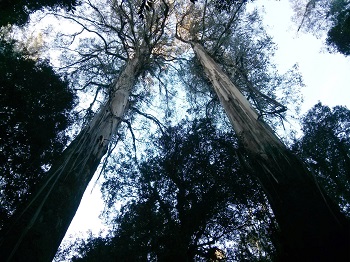The genetic and demographic impacts of contemporary disturbance regimes in mountain ash forests
Anthropogenic influences are modifying the natural disturbance regimes of forest ecosystems globally. Timber harvesting, frequent wildfires and a changing climate are influencing ecosystem composition, structure and function, with resulting losses to biodiversity and economic indicators. In south-eastern Australia, these factors are causing the rapid ecosystem collapse of montane forests, where foundation species rely on particular fire regimes for regeneration and maintenance of ecosystem integrity.
During this thoroughly enjoyable PhD project, we endeavoured to characterise and quantify the demographic and genetic impacts that changing environments are having on mountain ash (Eucalyptus regnans), a foundation species and one of the world’s tallest trees. We investigated a range of topics, including:
- the response of growth rates and seed production to stand age under different environmental conditions,
- the extent of hybridisation with messmate stringybark (Eucalyptus obliqua),
- whether fire and silvicultural practices are modifying patterns of within- and among-population genetic diversity and fine-scale spatial genetic structure of mountain ash in the Central Highlands of Victoria, and
- signatures of local adaptation in the mountain ash genome at a regional and range-wide spatial scale.
Progress
This project produced novel insights into the demographic and genetic impacts that modified disturbance regimes have on an ecologically and economically important foundation tree species. We found geographic variation in vital rates; population genetic patterns suggestive of high pollen flow and limited seed dispersal (indicating low recolonisation ability); high levels of within-population genetic variation (implying high adaptive capacity); frequent hybridisation with a fire-tolerant congener (suggesting potential for adaptive introgression); minor impacts of silviculture on nuclear genetic diversity; and different genomic architectures of local adaptation at different spatial scales. Importantly, furthering our understanding of all these aspects will assist with the conservation management of foundation tree species and forest ecosystems, and contribute to the maintenance and/or maximisation of adaptive capacity, allowing forests to persist into a changing and uncertain future.
Selected publications
von Takach, B., Ahrens, C. W., Lindenmayer, D. B., and Banks, S. C. (2021) Scale-dependent signatures of local adaptation in a foundation tree species. Molecular Ecology 30, 2248–2261. https://doi.org/10.1111/mec.15894.
von Takach Dukai, B., Peakall, R., Lindenmayer, D. B., and Banks, S. C. (2020). The influence of fire and silvicultural practices on the landscape-scale genetic structure of an Australian foundation tree species. Conservation Genetics 21, 231–246. https://doi.org/10.1007/s10592-019-01245-6.
von Takach Dukai, B., Jack, C., Borevitz, J., Lindenmayer, D. B., and Banks, S. C. (2019). Pervasive admixture between eucalypt species has consequences for conservation and assisted migration. Evolutionary Applications 12, 845–860. https://doi.org/10.1111/eva.12761.
von Takach Dukai, B., Lindenmayer, D. B., and Banks, S. C. (2018). Environmental influences on growth and reproductive maturation of a keystone forest tree: Implications for obligate seeder susceptibility to frequent fire. Forest Ecology and Management 411, 108–119. https://doi.org/10.1016/j.foreco.2018.01.014.
